|
Cross,
Crescent and Star - Jerusalem, Israel
Greetings
from the Jerusalem, the holiest of Holy, melting
pot of the three great religions, Islam,
Christianity,
and Judaism, torn in two by Middle East strife. We
spent a glorious two weeks here, and it was not
nearly
enough, there is just too much to experience.
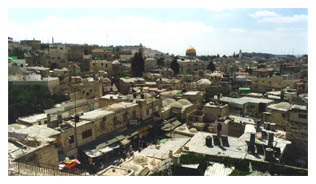
The city is divided into the Old fortified City and
the new modern area, roughly east and west Jerusalem. And although not on any map, it is also divided into Jewish and
Arab Jerusalem, and the
cause of so much tension and violence. The new city
is
a modern district with not much in the way of
'tourist
sites' For pure atmosphere and a true time warp, the
Old City is where it's at. The Old City is surrounded
by large medieval fortified brick walls complete with
towers, moats and murder holes (large openings
through
which boiling oil was poured over besieging armies.)
The old city is divided into four quarters, the
Muslim Quarter, the Christian Quarter, the Jewish
Quarter, and the Armenian Quarter. Each has its own
distinct character and feeling.
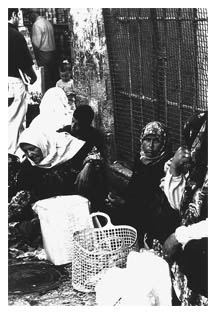 The Muslim Quarter is comprised mainly of the
bustling
souq. Small narrow covered alleys twist and
wind through tight buildings, light peeking in
through holes in the crumbling roof. Stores stock
everything, from gaudy souvenirs to toilet paper and
XXXXXL underwear. It's shoulder to shoulder all the time, which makes the tractors so much fun. They
pull large carts, mowing people down who
don't heed their call. Store owners throw trash in as the tractor
passes buy, but it doesn't always make it in. The Muslim Quarter is comprised mainly of the
bustling
souq. Small narrow covered alleys twist and
wind through tight buildings, light peeking in
through holes in the crumbling roof. Stores stock
everything, from gaudy souvenirs to toilet paper and
XXXXXL underwear. It's shoulder to shoulder all the time, which makes the tractors so much fun. They
pull large carts, mowing people down who
don't heed their call. Store owners throw trash in as the tractor
passes buy, but it doesn't always make it in.
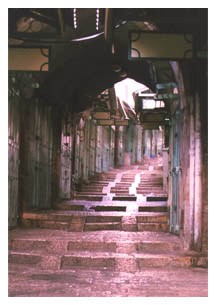 Parts of the market are dedicated to certain wares,
such as the silk market or the meat market. The
latter
in which you can come face to face with a goat head, sans
skin and lower jaw, its tongue (a delicacy) hanging
slack and eyes (another delicacy) clouded over.
Parts of the market are dedicated to certain wares,
such as the silk market or the meat market. The
latter
in which you can come face to face with a goat head, sans
skin and lower jaw, its tongue (a delicacy) hanging
slack and eyes (another delicacy) clouded over.
Also
here, deep with the labyrinthe are the delightful hummos
joints, where a meal is a plae of hummos, a fresh onion and a pile of
pitas. It is all a big maze and bustling all the time...
except
for this quiet moment, about 5:00 am when I am rushing to mass at
the Church of the Holy Sepulchre.

 Dome
of the Rock Dome
of the Rock
The
Quarter is also home to the Temple Mount, site of
both
destroyed Jewish Temples and the current location of
the Dome of the Rock and the Al-Asqa Mosque. The Dome
of the Rock, an amazing octangonal mosque built around the supposed stone where Abraham was to sacrifice his son and later Mohammed ascended to Heaven on his famous 'Night Journey.' The interior,
is
dominated by the enormous rock, and it is considered
the third holiest spot in the Islam faith, after
Mecca
and Medina. The mount itself is rather empty and sparse, just dry,
dusty land with little ornamentation. The Temple Mount is surrounded by the
remains of a wall that support it, the Western Wall.
The Jewish Quarter in contrast, has upmarket stores
of expensive Judiaca and religious items. The streets
are filled with synagogues. One evening, we wandered
onto an Orthodox wedding in a ruined synagogue. The
top of the synagogue had been blown off during the Israeli War of
Independence (1948), and it was never
restored. Instead, they continue to gather under the
stars and this wedding was no exception. Their joy at the
occasion, the singing spreading throughout the evening and their
infectious dancing was heartwarming to behold.
But the highlight is the Western Wall, better known as the
Wailing Wall, the one remaining temple wall of the 2nd
Jewish Temple destroyed in 70 AD by the Romans. This
unbelievable structure is so commanding, not because
of the actual wall itself, but for the collective
religious fervour that amasses at the base. Upon
closer inspection, the cracks in the wall are filled
with thousands of pieces of paper, on which people
bring their prayers before God. In theory, this
is a hotline to God. For those of you at home, the
wall has gone digital. You can fax or email prayers and it will be printed out and stuck in the
wall. The area in front is filled with Jews praying,
singing, dancing, and celebrating, many of them, Orthodox, wearing the black jackets and hats, and
Ultra-Orthodox wearing long black silk robes and
large
fur-covered hats. The women are separated from the
men
by a large barrier splitting the wall in
half-actually
the men get more.
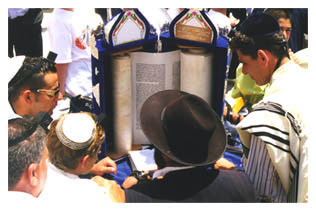
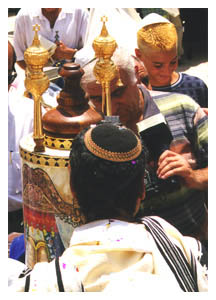 One day, we came across a dozen
bar mitzvahs occurring simultaneously at the wall, the
young boys reading from the Torah, while their
mothers
tossed candies at them from over the barrier. Once
done with reading, they were carried on their fathers'
shoulders and there was much celebrating. One day, we came across a dozen
bar mitzvahs occurring simultaneously at the wall, the
young boys reading from the Torah, while their
mothers
tossed candies at them from over the barrier. Once
done with reading, they were carried on their fathers'
shoulders and there was much celebrating.
The
Torah inside it's elaborate case at the Wailing Wall
The Armenian Quarter was the quietest of the bunch. Very low key, we visited the one church open to the
public celebrating an Armenian orthodox mass. We sat
on the carpeted floor as hooded priests went to and fro chanting all the while, and swinging the incense
burner to fill the air. You can also tour the
Armenian
Museum, dedicated to what they call the first
genocide
of the twentieth century, the death of a million and
a half Armenians at the hands of the Ottoman Turks
in 1915. The dark streets are postered with signs
demanding some restitution and recognition of the
tragedy from the Turkish government, and an air of
sadness fills the streets.
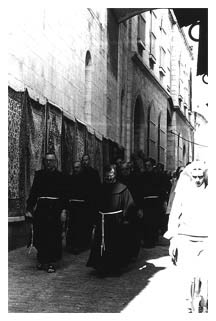 The Christian Quarter is dominated by the Church of the Holy Sepulchre, built on the spot of Golgotha, or
Calvery Hill, where Christ was crucified. On Friday right at 3:00,
we participated in a procession of the Stations of the Cross, led by Franciscan Monks. The Christian Quarter is dominated by the Church of the Holy Sepulchre, built on the spot of Golgotha, or
Calvery Hill, where Christ was crucified. On Friday right at 3:00,
we participated in a procession of the Stations of the Cross, led by Franciscan Monks.
Monks
leading the stations of the cross near station #3 where Jesus fell to his
knees for the first time.
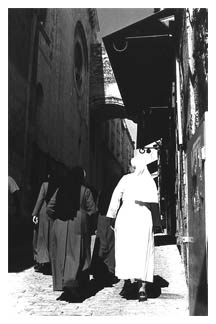 We stopped at
each sight, reading from the Bible in both Latin and
English, and chanting while we walked the same path that Jesus took as he approached Calvery Hill. The
last four stations are all within the Church itself, from the spot of the
crucifiction to the Selpuchre
itself, spot of the tomb of Christ and his
subsequent resurrection. We stopped at
each sight, reading from the Bible in both Latin and
English, and chanting while we walked the same path that Jesus took as he approached Calvery Hill. The
last four stations are all within the Church itself, from the spot of the
crucifiction to the Selpuchre
itself, spot of the tomb of Christ and his
subsequent resurrection.
The church itself, far from
being the tranquil holy spot we had hoped it would
be,
suffers from infighting among various branches of
the
Christian church. The actual church is divided into
five areas, Roman Catholic, Coptic, Greek Orthodox,
Syrian Orthodox, and Armenian Orthodox. Literally, there are invisible lines separating the dominion of
each group, and they quarrel about changing light
bulbs, or any group doing anything outside their
area.
This has had disastrous consequences for the building itself
because the groups cannot agree on anything
concerning
restoration. Instead, the church falls into disrepair, while they continue to quarrel.
This is nothing new. Seems they have been fighting
for
so long, that 800 years ago, they gave the keys to
the one entrance to the church to an unbiased outsider, an Arab Muslim, and his family has held the
keys to the church for all this time. Each morning,
the key-holder gets up and opens the doors at 5:00 am
sharp to this day.
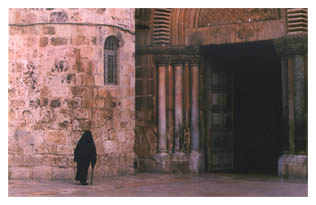
On Sunday, I attended 6:30 a.m. mass
held in front of the Selpuchre.
It was a traditional
Latin mass attended mainly by monks and nuns, most
tourists not rising at that hour. Turns out there was
three masses at the same time, and the cacophony of
chanting, singing and organ music could only happen in
Jerusalem, the city of eternal conflict.
Of note, on the columns surrounding the front doors to the church, are a
thousand years of graffiti, pilgrims coming and leaving an eternal
signature of their visit.
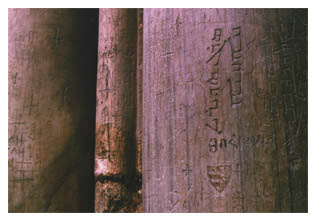
The most unique experience we had in Jerusalem was Hezekiah's Tunnel. Built in 701 BC, it was built
to divert the flow of a natural water spring from
outside the city walls, to a protected location. In this way, the city would be secured a constant source
of water and besieging armies would be defeated by
the
lack of water. You are allowed to travel the length
of
the tunnel, about a mile long. The kicker, it is
pitch black and filled with ice cold rushing water up
to your thighs in some places. With only the light of
our mini-mag, we slowly
made our way through, the ground beneath the water
rough, uneven and filled with potholes. Definately
not
for the claustrophobic, the ceiling height ranged
from
cavernous to about four and half feet high and the
walls were never more than shoulder width apart. A must for anyone to Jerusalem.
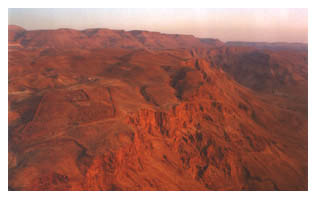
view
from Masada - the diamond shape to the left is the remnants of the ancient
Roman force
From our base in Jerusalem, we took some day trips.
One to Masada, infamous ruins atop a large mountain, in which
the story is far more dramatic than the actual ruin. We arrived at the hill at five in the morning, to
avoid the heat while climbing the mountain. A steady
hour climb to the top while the sun slowly rose, we
reached the top, drenched in sweat. The mountaintop
was home to a thousand Jewish settlers in 73 AD.
After
the temple was destroyed in Jerusalem, the Romans
turned their attention to Masada, hoping to defeat
them. For three years, the Jews successfully repelled
the Romans, but at last, with defeat imminent, they
made an elaborate suicide pact, whereby each man killed his family, then lots were drawn to determine
the last man who would kill all the other men, then
himself. The Romans reached the top to find 994 dead,
with a women and her children who had hidden, the sole survivors. Today, it stands as a monument to
Jewish heroism, and the rallying cry, Masada shall
not
fall again.
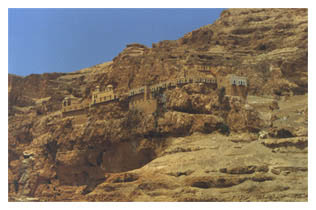
We
also wandered in the desert where Jesus fasted for 40 days and 40 nights.
Here at the Mount of Temptation, stands an imposing Greek Orthodox
Monastery built into the cliff face and nearby the rock where Jesus was
tempted by the Devil. Almost deserted, the few monks left lead a solitary
life, seldom interrupted by tourists who don't bother to make the journey
up.
We also visited Bethlehem in the West Bank, under
Palestinian control. There we saw the Milk Grotto, a
resting spot of the Holy Family as they fled to
Egypt.
There, Mary spilled a drop of milk while nursing the
baby Jesus, turning the rock chalky white. Today, it
is a shrine to infertile couples who flock to receive
a bit of the chalky white powder in hopes of conceiving. And of course, the Amusement Park of the
Nativity. We thought Jerusalem was bad. The Church of
the Nativity is an amusement park, right down to the long lines into the grotto where Jesus was born and
the hawkers/priests selling holy water and oil, candles
and prayer flash cards. The people in line were
clamoring to get a photo of themselves smiling,
their
head under the alter at the spot of his birth. We got
right out. The whole area is under construction for the flood of tourists expected
in Bethlehem in 2000.

spot
where Jesus was born...sans my head
And lastly, we went back to Tel Aviv for a little
culture. Straight from London, the rave-reviewed
production of Shock-Headed Peter, a collection of
gruesomely delightful children's tales sung to the
musical stylings of the Tiger Lilies. It was
brilliant
and we highly recommend it when it is sure to come to
America.
Well that is a mouthful. Til next time.
Ann and Doug
index | back
| next |
